
No Comments on A Review of REHABDATA 244
Janice Masud-Paul, MLIS, MPH
Health Sciences Librarian
Drexel University
REHABDATA is the primary repository of the National Rehabilitation Information Center (NARIC). NARIC and its databases are funded by the National Institution on Disability, Independent Living, and Rehabilitation Research (NIDILRR), the research arm of the Administration for Community Living. In accordance with the NIDILRR mission, they provide funding to improve the lives of people with disabilities and promote their full participation in the community.1 NARIC contains three searchable collections, which are accessible from the following tabs on NARIC’s home page:
1. The Articles, Books & Reports tab contains the REHABDATA Collection
2. The Research Projects tab links to NIDILRR’s Program Database of current and past research projects
3. The Knowledgebase tab links to a database of organizations and agencies that support people with disabilities.
This review focuses on the REHABDATA collection, but users may want to search across all databases and browsable tabs to find information from grey literature, funded projects, and other unique materials. Access to NARIC’s citations is free.
Content
REHABDATA includes more than 340,000 records of research literature covering physical and mental disability, independent living, vocational rehabilitation, special education, assistive technology, law, employment, and other issues as they relate to people with disabilities.2 The collection contains national and international coverage with more than 120,000 abstracts absorbed from the retired Center for International Rehabilitation Research (CIRRIE).2 The database spans from 1956 to the present. On average, indexers add more than 4,000 items to REHABDATA annually. (NARIC information specialist, email, January 2023)
Approximately 50% of their documents are articles indexed from 150 peer-reviewed and scholarly journals.3 The balance of the collection are materials funded by NIDILRR including technical reports, fact sheets, curriculum guides, and consumer-focused materials. In addition to reports and articles, the collection contains commercial books about and for persons with disabilities. Materials are available in print and multimedia formats. Although records are primarily document summaries, selected entries contain PDF links to full text. Print documents are also available through document delivery services for a small fee.
Features / Functionality
Users can browse or search REHABDATA. Materials are browsable by journal title, book publisher, recent acquisitions, and keywords (subject headings) from the REHABDATA Thesaurus, 9th edition.3 The thesaurus contains headings selected by REHABDATA abstractors with scope notes, and as applicable, broader, narrower, and related terms. Many entries also include a crosswalk of terms and concepts from the World Health Organization’s International Classification of Functioning, Disability and Health (ICF), which is used by public health organizations globally. Each REHABDATA article is typically indexed with 5-10 terms from the REHABDATA thesaurus (information specialist at NARIC, phone call, December 2022).
Although users can perform a keyword search from the main page of NARIC.com, the Advanced Search screen under the Articles, Books & Reports tab is recommended for a more targeted search.4 The Advanced Search platform provides free-text search options across all fields with implied Boolean operators. For example, a search in the “with all these words” field is an implied AND operator; “with at least one of these words” is equivalent to an OR operator. Users can search for exact phrases using the “with this exact phrase” option or exclude those terms in the “without these words” field. Asterisks denote wildcard searches.
Users can also search within specific Title, Author, Abstract, Descriptor, Year of Publication, and NIDILRR/ACL grant number fields. Year or range of years, online full text availability, and international research are limited options.
I conducted a search on “pain evaluation for patients with cognitive impairment OR dementia” to assess the functionality and features of REHABDATA. I initially tried the Specific Field option for “pain evaluation” AND “cognitive impairment” OR dementia in the abstract fields. However, this search retrieved over 1,000 abstracts and was too sensitive for my topic. The search boxes did not seem to recognize quotation marks to designate phrases.
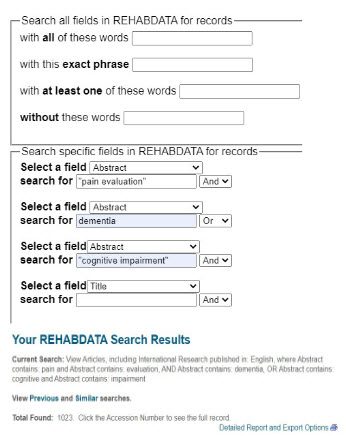
My second attempt searched across all fields and yielded more relevant search results. Note that the “exact phase” box was required to find adjacent terms. When “cognitive impairment” was entered in the “at least one of these words” field, REHABDATA ignored the Boolean OR and searched for these terms individually using an implied OR, even though the words were enclosed in quotes.
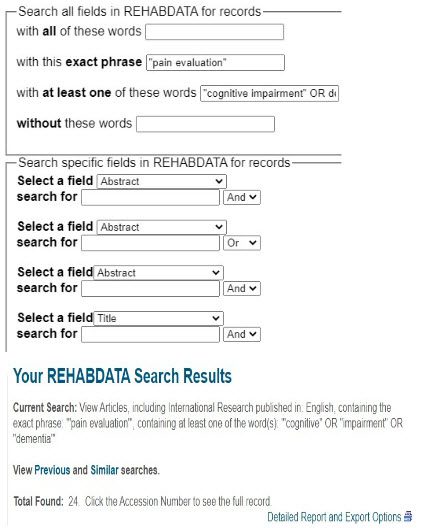
Users can limit search results to documents available online or the NARIC document delivery service. Not all digital documents are available directly from REHABDATA, as users may be linked to an article that requires a journal subscription for full text access. Documents available to download from NARIC will include a Download Article in Full Text hyperlink, which links to a PDF.5 Obtaining documents through local academic and/ or public libraries is also encouraged.5
Articles with a Document Delivery Service link in their detailed record are available in print from NARIC via standard mail for a nominal fee to anyone in the United States. NARIC does not offer an electronic delivery option for this service.
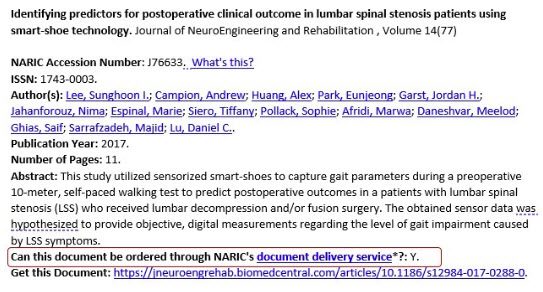
Search results are listed chronologically, and citations fields include (1) title, (2) authors, (3) year of publication, and a hyperlinked (4) accession number which links to the full record.
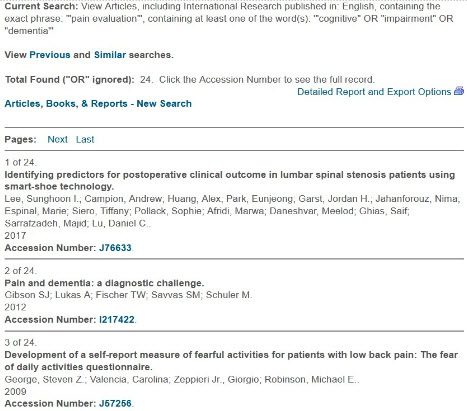
The BACK button provided convenient navigation from the full record to the result list.
Users can view their previous search results by using the “View Previous Searches” hyperlink. Users who wish to edit a previous search strategy must rely on their browser’s back arrow to navigate to that page.
Users can select the Detailed Report and Export Options link to check off items from the result page for a bibliography. Records can be exported for download in XML format and imported for processing in software programs like Excel. Users may need to convert their results to a comma-delimited file before importing them into a bibliographic citation tool such as Endnote.
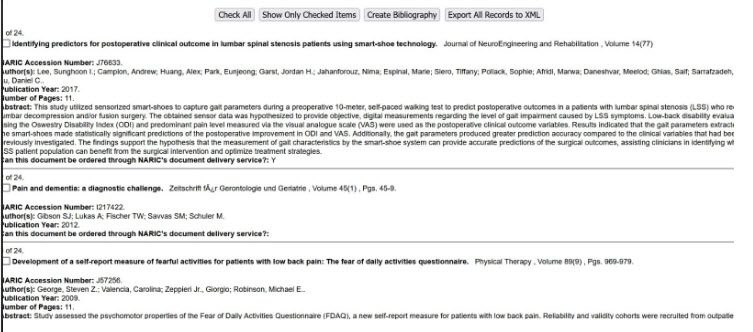
Database assistance
Reference and literature search assistance is available from information specialists via phone and live chat during library business hours, Monday through Friday. The chat service specialists are very friendly and efficient. Online information request forms are also available for email assistance. There is extensive online help to assist users via FAQ pages and guides. Additional help links at point-of-need take users to a detailed webpage that covers questions such as “Where do I start?” and “How do I search for what I need?” 5 NARIC has a strong social media presence on Twitter, Facebook, Pinterest, and Google Plus in English and Spanish.6
Database features to add or improve
REHABDATA has not had any major user interface revision for many years, although one is planned for the near future (information specialist at NARIC, phone call, December 2022). I did not find their current Advanced Search features intuitive. The Search All Fields option has a basic interface that is helpful for simple searches but restrictive for complex searches that combine phrase searching with Boolean operators such as the search below.
“patient evaluation” AND (“cognitive impairment” OR dementia)
As mentioned previously, phrase searches must occur in the “with this Exact Phrase” field, otherwise the adjacency is ignored, and the terms are joined by the OR operator. This increases search sensitivity but lowers specificity.
A back button or link that allows users to view their search history and edit their search strategies would be a welcome navigation feature. Options beyond XML for downloading results would make data handling more efficient for literature searches and systematic reviews.
Breakthrough
The disability/rehabilitation focus of this collection is unique and extensive with an impressive list of international articles – as of 2003, about 10% of journals indexed in the collection were edited and published outside of the U.S.7 More recent data were unavailable at the time of this writing. Their REHABDATA Thesaurus combined with the ICF Crosswalk is a comprehensive tool with terminology from national and international resources. It is especially useful for finding alternative terms when developing search strategies on disability and rehabilitation topics across multiple databases.
Users who want to stay current on developments in the disability community may want to subscribe to REHABDATA Connection — a monthly alert service that emails brief abstracts and links for topics users choose from a selected list.8 Although not covered by this review, the NARIC database also has excellent outreach through social media for members of the NIDILRR community drawn from NARIC funded projects.
Help services, whether live or in print, are excellent and thorough. I would recommend this database in any comprehensive search for information on rehabilitation and disability for researchers across disciplines, as well as consumers. The fact that it is a free database makes it even more valuable for organizations and individuals that do not have access to commercial databases and resources.
1. Administration for community living. Research and Development. Updated 2019. Accessed December 21, 2022. https://acl.gov/programs/research-and-development
2. National Rehabilitation Information Center. Explore REHABDATA. Accessed December 27, 2022. https://www.naric.com/?q=REHABDATA
3. National Rehabilitation Information Center. Introduction. Accessed December 26, 2022. https://naric.com/sites/default/files/Thesaurus%20v9%20intro.pdf
4. National Rehabilitation Information Center. Get to know NARIC presentation-pt2 Accessed December 6, 2022. https://www.naric.com/?q=en/content/get-know-naric
5. National Rehabilitation information center. Access digital copies of documents indexed in REHABDATA. Accessed December 27, 2022. https://www.naric.com/?q=node/106
6. National Rehabilitation Information Center. Where do I start? Searching NARIC’s Resources. Accessed December 27, 2022. https://www.naric.com/?q=content/where-do-i-start-searching-narics-resources
7. Ackerman P. Report: Forum on International Collaborative Research in Rehabilitation. July 23, 2003.
http://cirrie-sphhp.webapps.buffalo.edu/conferences/proceedings/2003/report.php
8. National Rehabilitation Information Center. REHABDATA Connection Subscription Form. Accessed December 27, 2022. https://www.naric.com/?q=en/RehabdataConnection


Leave a comment